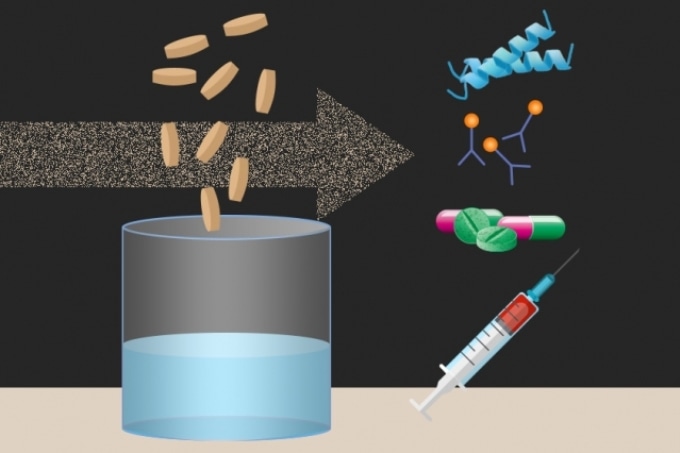Sep 23 2016
 Researchers at MIT and other institutions have created tiny freeze-dried pellets that include all of the molecular machinery needed to translate DNA into proteins, which could form the basis for on-demand production of drugs and vaccines. (Image: Christine Daniloff/MIT. Antimicrobial peptide illustration by Ymahn/Wikimedia Commons)
Researchers at MIT and other institutions have created tiny freeze-dried pellets that include all of the molecular machinery needed to translate DNA into proteins, which could form the basis for on-demand production of drugs and vaccines. (Image: Christine Daniloff/MIT. Antimicrobial peptide illustration by Ymahn/Wikimedia Commons)
A team of researchers at MIT and other institutions have developed miniature freeze-dried pellets that possess all of the molecular machinery required to convert DNA into proteins, which could form the basis for on-demand production of vaccines and drugs.
The pellets, which hold several enzymes and other molecules extracted from cells, can be stored for prolonged period of time at room temperature. When water and freeze-dried DNA are added, the pellets start to produce proteins encoded by the DNA.
It’s a modular system that can be programmed to make what you need, on the spot. You could have hundreds of different DNA pellets you can add in the field.
James Collins, Termeer Professor of Medical Engineering and Science, MIT
The diameter of these pellets measure a few millimeters, and could be easily carried by astronauts, health care workers, or soldiers going to remote areas, says Collins, who is the senior author of a research paper illustrating this approach in the September. 22 online edition of Cell.
The research paper’s lead authors are Keith Pardee, an assistant professor at the University of Toronto and former research scientist at Harvard University’s Wyss Institute for Biologically Inspired Engineering; Shimyn Slomovic, an IMES postdoc; Jeong Wook Lee, a Wyss Institute research scientist; and Peter Nguyen, a Wyss Institute Technology Fellow.
Cell-Free Synthesis
In the past, Collins and several others in the developing field of synthetic biology have created cells to execute multiple functions that they did not normally possess, such as fabricating biofuels or drugs. During the past few years, Collins has demonstrated that this kind of design can also be achieved outside of cells, by extracting the required cellular components and freeze-drying them onto materials such as paper.
The cell-free extracts consist of a few dozen enzymes, DNA, and RNA, as well as ribosomes and other molecular machines leading to transcription and translation.
James Collins, Termeer Professor of Medical Engineering and Science, MIT
In the recent study, the team removed the paper from the approach. The cellular extracts are just freeze-dried into pellets, which stay stable for about a year. Protein production is triggered when the researchers rehydrate the pellets using water, together with freeze-dried DNA that encodes the preferred protein.
This approach could be useful to produce a number of products, including both molecules and drugs that could be applied to diagnose illness. In the Cell study, the researchers created small proteins that could be applied as a diphtheria vaccine, as well as antimicrobial peptides, which can probably be used to fight bacterial infections.
They also designed the pellets to produce enzymes capable of forming a multistep metabolic pathway that synthesizes a complex drug called violacein. This drug has antibiotic and anti-cancer action.
For diagnostic applications, the team used the pellets to generate many types of antibodies, including one that is capable of detecting the bacterium Clostridium difficile, which can cause serious inflammation of the colon.
Easy Storage
Compared to using live cells to generate biopharmaceuticals, this approach may be easier as the freeze-dried components are easy to store and ship, and do not require refrigeration.
Collins and colleagues paint a future where freeze-dried, cell-free biomanufacturing platforms can be used to synthesize therapeutics, vaccines, and biochemicals on demand, without the need for a cold [supply] chain. By moving manufacturing from the factory to the front lines, we might be able to provide patient-specific medicines where medicines are not available now.
Michael Jewett, Associate Professor, Northwestern University
Collins predicts that this type of technology is likely to be useful in many settings.
“It could be used in a very simple carry kit for health care workers going in the field in developing regions,” he says. “We think it could be very useful for the military, when you’re going out on a mission in the field, or for hikers and athletes going for long hauls. You could even have it in the back of your car as an expanded first aid kit.”
These pellets could also be integrated into educational tools — “the biotech equivalent of a chemistry kit,” Collins says. “You could envision using these pellets to allow students to conduct synthetic biology experiments at home, or in middle schools and high schools.”
Another application Collins is keen on pursuing is combining the pellets into “smart bandages” that would be capable of detecting an infection and then would initiate production of the suitable antimicrobial peptide to treat the infection.
The research received funding from the Wyss Institute; the Ragon Institute of MGH, MIT, and Harvard; the Paul G. Allen Frontiers Group; and the Defense Threat Reduction Agency.